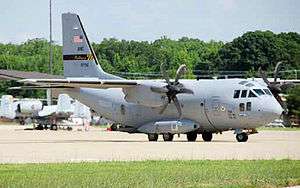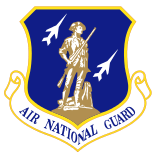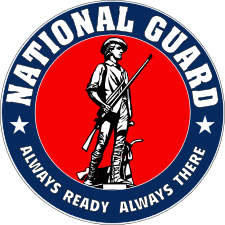Maryland Air National Guard
| Maryland Air National Guard | |
|---|---|
|
104th Fighter Squadron formation of A-10 Thunderbolt IIs, Warfield AGB. The 104th is the oldest unit in the Maryland Air National Guard, having over 90 years of service to the state and nation.
A C-27J Spartan from the 135th Airlift Squadron in 2012 | |
| Active | June 29, 1921 – present |
| Country |
|
| Allegiance |
|
| Branch | United States Air Force |
| Role | "To meet state and federal mission responsibilities." |
| Part of |
Maryland Military Department United States National Guard Bureau |
| Garrison/HQ | Maryland Air National Guard, Fifth Regiment Armory, 219 29th Division St., Baltimore, Maryland 21201 |
| Commanders | |
| Civilian leadership |
President Barack Obama (Commander-in-Chief) Deborah Lee James (Secretary of the Air Force) Governor Larry Hogan (Governor of the State of Maryland) |
| State military leadership | Brigadier General Scott L. Kelly |
| Insignia | |
| Emblem of the Maryland Army and Air National Guard |
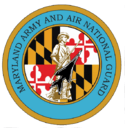 |
| Aircraft flown | |
| Attack | A-10C Thunderbolt II |
| Transport | C-27J Spartan, C-130J Super Hercules |
The Maryland Air National Guard (MD ANG) is the air force militia of the State of Maryland, United States of America and a reserve component of the United States Air Force. It is, along with the Maryland Army National Guard, an element of the Maryland National Guard.
As state militia units, the units in the Maryland Air National Guard are not actively in the United States Air Force chain of command until federalized. They are under the jurisdiction of the Governor of Maryland though the office of the Maryland Adjutant General unless they are federalized by order of the President of the United States. The Maryland Air National Guard is headquartered in Baltimore, and its commander is Brigadier General Allyson Solomon.
Overview
Under the "Total Force" concept, Maryland Air National Guard units are considered to be Air Reserve Components (ARC) of the United States Air Force (USAF). Maryland ANG units are trained and equipped by the Air Force and are operationally gained by a Major Command of the USAF if federalized. In addition, the Maryland Air National Guard forces are assigned to Air Expeditionary Forces and are subject to deployment tasking orders along with their active duty and Air Force Reserve counterparts in their assigned cycle deployment window.
Along with their federal reserve obligations, as state militia units the elements of the Maryland ANG are subject to being activated by order of the Governor to provide protection of life and property, and preserve peace, order and public safety. State missions include disaster relief in times of earthquakes, hurricanes, floods and forest fires, search and rescue, protection of vital public services, and support to civil defense.
Components
The Maryland Air National Guard consists of the following major components:
- Headquarters, Maryland Air National Guard
- Stationed at: Fifth Regiment Armory, Baltimore
- Established 1 October 1962 (as the 175th Tactical Fighter Group; operates: A-10 Thunderbolt II
- Stationed at: Warfield Air National Guard Base, Middle River
- The 175th Wing is primarily a fighter unit. The 175 WG has two active USAF gaining commands: the Air Combat Command for its fighter aircraft and United States Air Forces in Europe for its 235th Civil Engineer Flight.[1]
History
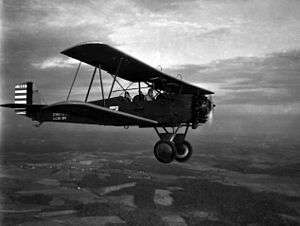
The Maryland Air National Guard traces its origins to 29 June 1921. On that date the 104th Observation Squadron was federally recognized in Baltimore.[2] It became the first post-World War I National Guard unit to be equipped with its own aircraft, 13 Curtiss JN-4 Jennies, which it flew until 1923. The unit was based at Logan Field in Baltimore.
The 104th was initially assigned as division aviation for the 29th Infantry Division. Their annual summer training encampments were at Langley Field, Virginia (until 1931) and Detrick Field, Maryland (1931–41). (Detrick Field, now Fort Detrick, was named for the squadron's flight surgeon, Captain Frederick Detrick.) In addition to Jennies, the 104th flew a variety of other aircraft during the interwar period. Shortly before the U.S. entry into World War II, the unit was transferred to the 59th Observation Group (now the 59th Medical Wing) as part of a larger reorganization of the U.S. Army Air Forces.
World War II
Along with the rest of the Maryland National Guard, the 104th was mobilized for federal service on 3 February 1941. During the war, the 104th flew anti-submarine patrols out of Atlantic City, N.J., in O-46s and was awarded campaign credit for participation in the Anti-Submarine Campaign.[3] In late 1942, the unit was inactivated and its personnel transferred to the 517th Bombardment Squadron, later redesignated the 12th Anti-Submarine Squadron, at Langley Field, Va. In the fall of 1943, the 12th was transferred to California and redesignated the 859th Bombardment Squadron. By this time most of its original National Guard members had been reassigned to other units as individual replacements.
Cold War
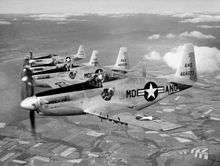
In 1946, the 104th was reactivated as the 104th Fighter Squadron at Baltimore Municipal Airport, equipped with P-47 Thunderbolt aircraft, later replaced by P-51 Mustangs. From 1955 to 1958, the unit was organized as a fighter-interceptor squadron and charged with defending the Baltimore-Washington area against possible Soviet bomber attack. The unit soon converted to F-86 Sabre, and in 1957 relocated to the Glenn L. Martin Company Airport, whose longer runway was necessary to support jet operations.
Maryland gained a second flying unit – and its first group-level headquarters – in 1955 when the 135th Air Resupply Group was organized at Harbor Field. The 135th was one of a handful of Air Force special operations units in existence at the time. Equipped with Curtiss C-46 Commando transports and SA-16 Albatross seaplanes, its mission was the covert infiltration, resupply, and extraction of special forces. Redesignated as the 135th Air Commando Group in 1963 and then the 135th Special Operations Group in 1968, it was one of only five such units throughout the Air National Guard. It remained at Harbor Field until 1960, when it too relocated to the Martin Company Airport.
A second group headquarters was added in 1962, when the 175th Tactical Fighter Group was established in October. The 104th Tactical Fighter Squadron, which had heretofore operated as an independent squadron, became a part of the new group.
The spring of 1968 brought considerable activity, with both the 135th and 175th being called out to help quell rioting in Baltimore following the assassination of Dr. Martin Luther King, Jr., and elements of the 175th being federalized and deployed to Cannon Air Force Base, N.M., in response to the USS Pueblo (AGER-2) in Korea. While mobilized, the unit conducted fighter ground attack training for Air Force pilots designated to be forward air controllers. The unit returned to Maryland and demobilized in December.
The Maryland Air National Guard endured multiple changes in designation and equipment during the 1970s. The 135th Special Operations Group switched first to a tactical air support role, where it flew forward air controller missions with O-2A Skymasters,[4] then in 1977, assumed a new mission and was redesignated the 135th Tactical Airlift Group and equipped with the de Havilland C-7A Caribou. In 1980, the unit converted to the C-130 Hercules aircraft.
The 175th Tactical Fighter Group also changed aircraft to meet the evolving needs of the Air Force. In 1970, the 175th turned in its F-86s and received A-37 Dragonflies in their place. Nine years later, in 1979, the unit was re-equipped with brand new A-10 Thunderbolt II aircraft from the Fairchild factory in Hagerstown, Maryland.
The military facilities at Martin State Airport were formally renamed the Warfield Air National Guard Base in honor of Maj Gen (Ret) Edwin Warfield III, former Adjutant General of Maryland, in 1982 and the base has since been known as Warfield Air National Guard Base. The civilian portion of the field had been obtained by the state and renamed Martin State Airport in 1975.
Gulf War and Peacekeeping
Despite the end of the Cold War, the Maryland Air National Guard remained heavily involved in operations around the world through the remainder of the century. During the build-up to the 1991 Persian Gulf War, a number of unit personnel were mobilized to fill support roles. Three Maryland C-130s were mobilized and deployed to Germany to “backfill” for aircraft being sent into the combat theater, while the unit’s Mobile Aerial Port Flight was called up and sent to Dover Air Force Base, Del. The same year, the 175th won Gunsmoke, the U.S. Air Force Worldwide Gunnery Competition, earning recognition as the best fighter unit in the Air Force.
The 135th participated in humanitarian relief efforts in Somalia, peacekeeping and humanitarian relief in Bosnia, the U.S. intervention in Haiti, and enforcement of U.N. sanctions against Iraq during the 1990s. A-10s from the 175th were likewise kept busy patrolling the skies over Bosnia-Herzegovina as a part of the U.N./NATO task force and enforcing the “no-fly” zone over southern Iraq, where it was called upon to fly retaliatory strikes against Iraqi targets.
On 15 June 1996, the two flying groups of the Maryland Air National Guard merged to form the 175th Wing. The 175th Wing, which carries on the lineage and honors of the 175th Fighter Group, is a composite organization with an Air Combat Command-gained fighter unit, and Air Mobility Command-gained airlift unit, a U.S. Air Forces in Europe-gained civil engineer flight, and, since 2006, an information operations squadron.
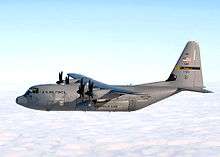
The wing has been deeply involved in fielding the latest Air Force aircraft. In 1999, it dedicated its first C-130J, the latest and most advanced version of the venerable transport. The 135th played a major role in the operational test and evaluation of the aircraft, procedures development and evaluation, and was the first fully equipped C-130J unit in the U.S. Air Force. In 2011, the unit again transitioned aircraft, this time to the new C-27J Spartan.
The wing was also selected as the lead unit to convert to the new A-10C – the first A-10 aircraft in the U.S. Air Force to be modified for precision engagement. Beginning in 2006, wing personnel were deeply involved in the test and evaluation process and in September 2007, the 104th Fighter Squadron became the first unit to take the A-10C into combat, when it deployed to Iraq.
War on Terror
Since the September 11 attacks, 2001, members of the Maryland Air National Guard have repeatedly volunteered or been mobilized to take part in the Global War on Terrorism. From January to June 2003, the 104th Fighter Squadron was deployed to Bagram Air Base, Afghanistan, where it flew strikes against Taliban and al Qaeda forces and earned the distinction of being the longest-deployed Air National Guard fighter squadron at Bagram. Elements of the 135th Airlift Group remained almost continuously deployed in support of the War on Terror from December 2004 to January 2007, flying combat airlift missions into Iraq, Afghanistan, the Horn of Africa, and elsewhere as part of the 746th Expeditionary Airlift Squadron.
In addition to its service overseas, the Maryland Air National Guard has remained fully engaged at home. When Hurricanes Katrina and Rita struck the Gulf Coast in 2005, the Maryland Air National Guard was among the first to respond. The 135th Airlift Group flew 42 relief missions and deployed nearly 200 troops to support recovery and relief efforts in Louisiana and Mississippi. From 2006 to 2008, the Maryland Air Guard deployed a number of members to Arizona in support of the U.S. Border Patrol’s efforts to secure the U.S-Mexico border.[5] As a result of the USAF's decision to divest itself of the C-27, the 135th Airlift Group inactivated in 2013, bringing 58 years of service to a close.
Notable members
- Jack L. Chalker, award-winning science fiction author
- Jack Turnbull, Olympic athlete and lacrosse legend
- Frederick Detrick, MD, flight surgeon and Fort Detrick namesake
- James Alvin Palmer, Baltimore Orioles Hall of Fame Pitcher
- Tom Young, novelist
See also
References
![]() This article incorporates public domain material from the Air Force Historical Research Agency website http://www.afhra.af.mil/.
This article incorporates public domain material from the Air Force Historical Research Agency website http://www.afhra.af.mil/.
- ↑ 175th Wing website
- ↑ Joseph H. Ewing: The 29th Infantry Division: A short history of a fighting division. Padacuh, Ky.: Turner Pub., 1992.
- ↑ William M. Armstrong: Baltimore in World War II. Arcadia Publishing, 2005. ISBN 0-7385-4189-3
- ↑ Harvey, Maj. William A., "Maryland's Air Guard", USAF Fighter Weapons Review, USAF Fighter Weapons School, 57th Fighter Weapons Wing, Nellis AFB, Nevada, Summer 1973, page 37.
- ↑ http://www.md.ngb.army.mil/XHTML/Organization/History/History.html
- Gross, Charles J (1996), The Air National Guard and the American Military Tradition, United States Dept. of Defense, ISBN 0160483026
- Maryland National Guard website
External links
| Wikimedia Commons has media related to Maryland Air National Guard. |

